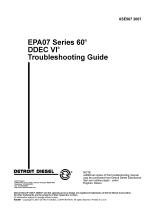
SECTION 00 : GENERAL INFORMATION
00-2
1. FOREWORD
This manual includes procedures for diagnosis,
service, maintenance and repair for components
of the H3 series coach or bus shell model listed
on the front cover page.
This manual should be kept in a handy place for
ready reference by the technician. If properly
used, it will meet the needs of the technician and
owner.
Information provided in Section 1 through 24
pertains to standard equipment items, systems
and components as well as the most commonly
used optional equipment and special equipment
offered on the coach models covered by this
manual.
At the beginning of each section; a Table of
Contents and a list of illustrations give the page
number on which each subject begins and
where each figure is located.
Coach operating information is provided in a
separate Operator's Manual. Audio/Video
system operator instructions are also included in
a separate manual.
More specific information on engine and
transmission operating, maintenance, and
overhaul information is contained in the
applicable engine or transmission service
manual published by the engine or transmission
manufacturer. Engine and transmission parts
information is contained in the applicable engine
or transmission parts catalog published by the
engine or transmission manufacturer.
All information, illustrations and specifications
contained in this manual are based on the latest
product information available at the time of
publication approval. The right is reserved to
make product changes at any time without
notice.
Note: Typical illustrations may be used,
therefore minor illustration difference may exist
when compared to actual parts or other
publications.
Prévost Car occasionally sends Maintenance
Information, Warranty Bulletins, Campaign
Bulletins or other literature to update users with
the latest service procedures. They are issued,
when required, to supplement or supersede
information in this manual. Update sheet should
be filled out and bulletins should be filed at the
end of their respective section for future
reference.
2. SCHEMATICS
Vehicle AIR SCHEMATICS are provided at the
end of Section 12, "Brake". SUSPENSION AIR
SCHEMATICS are provided at the end of
Section 16, "Suspension". Moreover,
ELECTRICAL SCHEMATICS are provided in the
technical publications box. Refer to those
schematics for detailed circuit information or
during diagnosis.
3. SAFETY NOTICE
This maintenance manual has been prepared in
order to assist skilled mechanics in the efficient
repair and maintenance of PRÉVOST vehicles.
This manual covers only the procedures as of
manufacturing date.
Safety features may be impaired if other than
genuine PRÉVOST parts are installed.
Torque wrench tightening specifications must be
strictly observed. Locking devices must be
installed or replaced by new ones, where
specified. If the efficiency of a locking device is
impaired, It must be replaced.
This manual emphasizes particular information
outlined by the wording and symbols:
Warning: Identifies an instruction which, if not
followed, could cause personal injuries.
Caution: Outlined an instruction which, if not
followed, could severely damage vehicle
components.
Note: Indicates supplementary information
needed to fully complete an instruction.
Although, the mere reading of such information
does not eliminate the hazard, understanding of
the information will promote its correct use.
3.1 DATA PLATES AND CERTIFICATIONS
Delay and confusion can be avoided by placing
the complete vehicle identification number of the
coach and the serial numbers of the engine on
parts orders and correspondence. Also, the
transmission, axles, power steering pump
chassis and other major components are
identified by serial numbers.
3.1.1 Engine
The engine serial and model number are
stamped on the cylinder block (as viewed from
the flywheel end) on the left side just below the





































